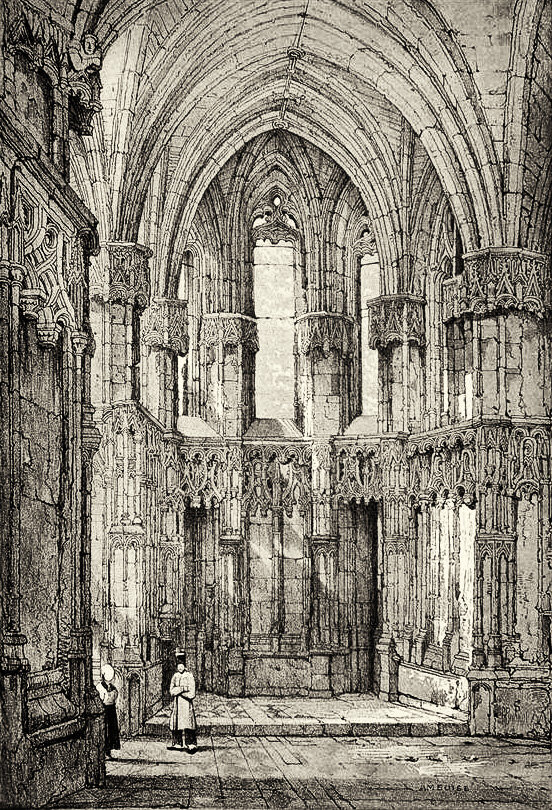Turner, Ruskin and the English Artists
Chateau Amboise 2021
Turner’s book, Wanderings By The Loire, inspired English artists to paint Château Amboise.
St Hubert’s Chapel, Samuel Prout.
Samuel Prout, Painter in Watercolours to Queen Victoria, visited three times. He was a great admirer of Turner. His boss, Queen Victoria, was not. When she asked for the best artist who could teach her to draw, Turner’s name was mentioned. She refused to meet him saying he was mad. She chose Edward Lear instead.
Chateau Amboise, William Callow
William Callow also followed in Turner’s footsteps. He would also have known the Château from its illustrious owner. After exhibiting a watercolour of Richmond Hill near the Thames in the Paris salon of 1831, King Louis Philippe, who knew Richmond Hill well having spent seventeen years exile in the area, invited Callow to teach his children Princess Clémentine and the Duc de Nemours. Callow befriended his other son François, prince de Joinville, during the July Revolution riots.
Chateau Amboise, Thomas Allom
Thomas Allom, founder member of the Royal Institute of British Architects (RIBA), who worked with Sir Charles Barry on the Houses of Parliament also painted the Château.
St. Denis Church Amboise, William James Muller
William James Muller from Bristol did more than visit. He was so enchanted with the Loire, he painted a series of sketches of French Renaissance architecture. Twenty-five were lithographed and published in 1841 as The Age of Francis I. of France.
The most famous of all the visiting artists was John Ruskin. He was only seven years old when Turner came to Amboise to paint the Château but when he was twenty-one he followed in his hero’s footsteps to paint his own impression of it.
It’s a watercolour view of a sunset with the moon rising in the distance shining through the famous bridge. He deliberately exaggerated the scale.
Chateau Amboise, Ruskin
Ruskin desperately wanted to capture Turner’s style. The sunset is reminiscent of Turner as is the moon rising behind it and the steps and balustrades (which are not there) going down to the river.
He worked this painting into a finished version. More detail was needed for an engraving which need particular visual elements for a print.
The Royal Château caught his imagination. It made such a strong impression on young Ruskin he wrote The Broken Chain a long, morbid, poem about it.
Those orbed towers obscure and vast,
That light the Loire with sunset last;
Those fretted groups of shaft and spire,
That crest Amboise’s cliff with fire,
When, far beneath, in moonlight fail
The winds that shook the pausing sail;
The panes that tint with dyes divine
The altar of St. Hubert’s shrine
He used his painting of St. Hubert’s Chapel to illustrate the poem. He said: … the fretwork of St. Hubert’s Chapel done very carefully in my own way, – I thought perhaps a little better than Turner ...the chapel, which crowns the precipice, though small, is one of the loveliest bits of rich detail in France. In reality it is terminated by a small wooden spire, which I have not represented, as it destroyed the grandeur of the outline.
Ruskin raved about Turner’s views of the Loire in Modern Painters: Volume One.
Ruskin met Turner as a boy when his father commissioned a few watercolours from the painter. They cast such a spell he was impelled to copy them. Some are so good they are often mistaken for Turners.
Incensed by Turner’s critics in the 1836 Summer Exhibition at the Royal Academy of Arts Ruskin wrote an article in his defence. He was sixteen. Turner, who was forty-six, requested it not be published but invited Ruskin to his studio to watch him paint.
Ruskin, who started collecting Turner when he was twenty, once paid a thousand guineas for seventeen of his watercolours (£16k today).
Although he could draw and paint better than most of the artists he admired, although he was Slade Professor of Fine Art at Oxford University, Ruskin never called himself or thought of himself as an artist.
When Turner died, he left behind more than 550 oil paintings, 2,000 watercolours, and 30,000 works on paper which Ruskin painstakingly catalogued.
Post by Pamela (BA History of Art), Photography by Mark
Pamela Shields
Paperback, Hardback and eBook







